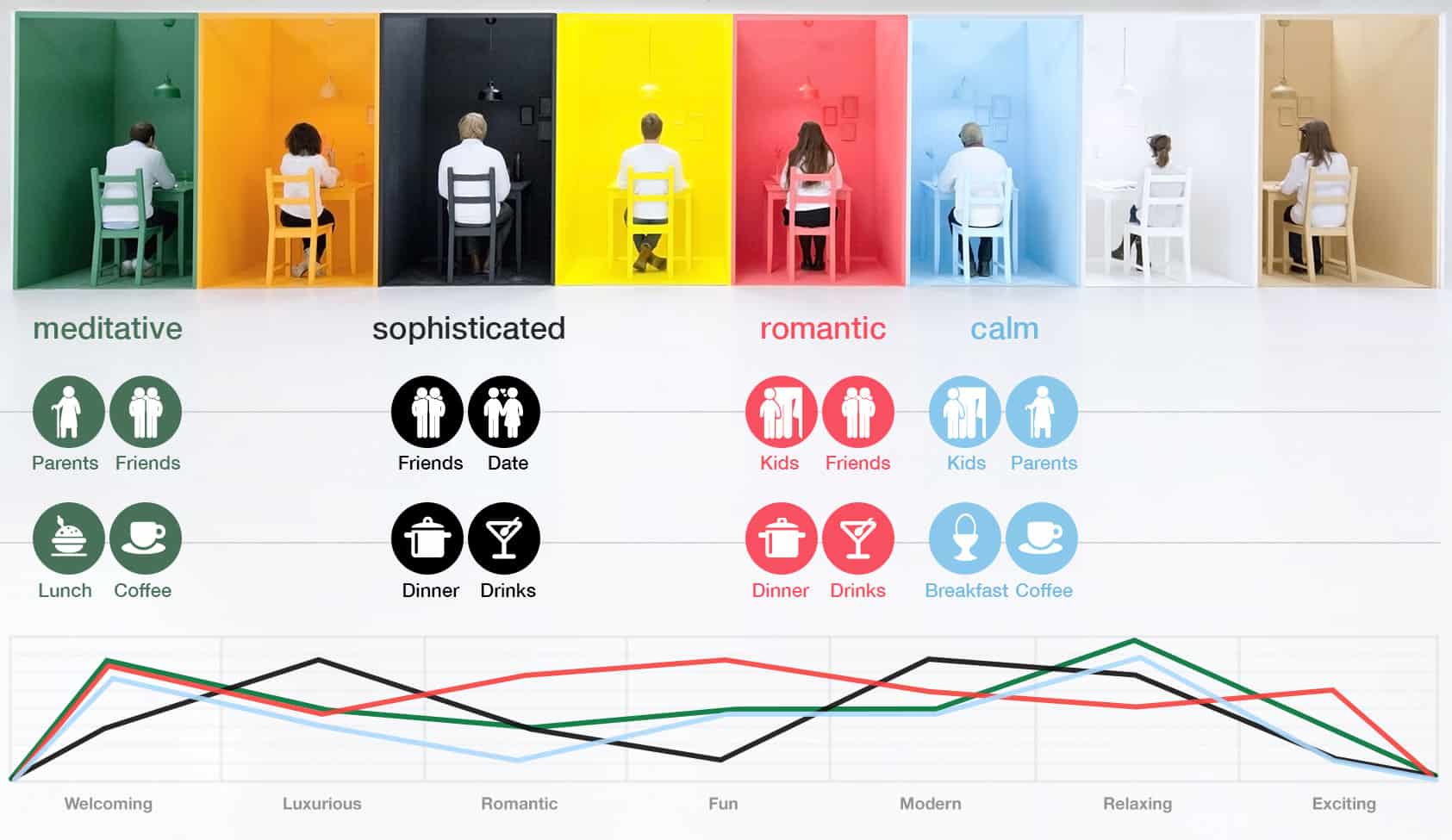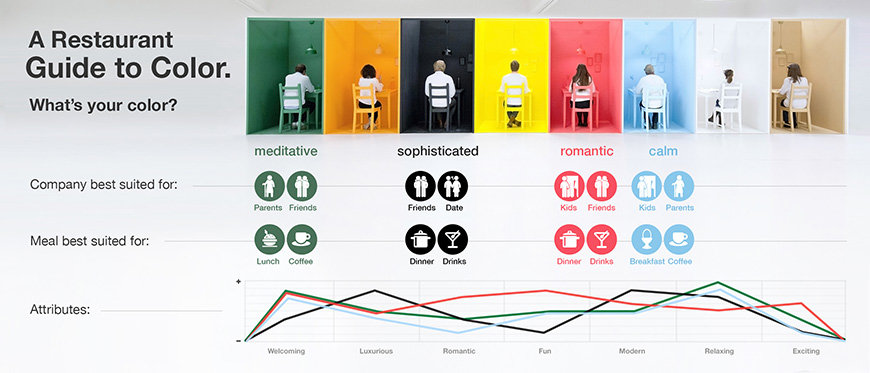Imagine yourself in a room bathed with green: Green paint on the walls and a green chair to sit in. On a green table there is a green plate – with a green napkin and a green macaron. When you reach down to take a bite of your macaron and take a sip of the green-colored drink in front of you, you react to the flavor. All the while, your body is physically reacting, too, through brainwaves, heart rate, even your appetite.
We know that color plays a vital role in your day-to-day life; red means stop, green means go. But have you ever stopped to consider how colors may affect the way restaurant guests respond to your establishment? With that question in mind, Tork created The Color Experiment to learn how color affects dining experiences.
Tork enlisted the help of eight restaurant guests. They experienced eight environments all identical with one exception: the color of the environment was different in each. Each setting was designed with restaurant attributes completely covered in a monochrome color – from walls and floor to furniture and tableware. All guests were equipped with tools that measure brain waves and heart rate. The analysis showed clear and reoccurring patterns in moods and emotions provoked by the different colors. Results also showed that participants perceived certain colors to be suitable for different kinds of meals and occasions – from a romantic dinner date to a formal business lunch. You can read more about the brain wave technology used in the experiment below.
So, what’s your color?

The Happy ORANGE
Guests saw orange as a modern and fun room, typically associated with happy experiences with kids and friends. Guests agreed that the orange room was unromantic, somewhat stressful and not luxurious. Brain wave and heart rate results indicated that orange is a more neutral color choice when compared to strong colors, like yellow. The results also indicated that learning and information processing could be boosted in an orange room. Guests said the best meals for orange were breakfast and lunch.
The Exciting YELLOW
Excitement and fun abounded in the yellow room! Brain wave results showed high states of arousal and conscious focus (but also showed somewhat higher stress levels). Guests perceived the yellow room to be suitable for breakfast and coffee, and also the most popular color room to bring kids.
The Romantic RED
Red is a stand out color – with brain waves showing strong emotional connection and high levels of creativity in this room. High heart rate results also confirmed that red was a stimulating environment. While some guests associated the red room with romance, others agreed that red was also an exciting and fun color. Guest said the red room the best company for the red room was friends and family, while the best suited meals were dinner and drinks.
The Meditative GREEN
Brain wave results from the Green room indicate a revitalizing quality associated with the color green, with restorative deep relaxation and immune system improvement. Heart rates were generally below average and guests described the room as “relaxing,” “calm,” and “welcoming.” Guests also said that the best company for the green room was friends and family, while the meals best suited for green were lunch and coffee.
The Calm BLUE
Brain waves showed that the blue room created deeply relaxed states in the guests, while also showing creativity and high emotional connection. Guests echoed these sentiments, calling the room “welcoming,” “calm,” and “relaxing.” Guests said that the blue room was best for families and a great ambiance in which to enjoy breakfast and coffee.
The Traditional BROWN
Brown, like blue and green, was seen as a color that encourages relaxation. The guests saw brown as a traditional and neutral color, as well. Guests thought the best company for the brown room was parents and colleagues, while best suited meals were breakfast and coffee.
The Sophisticated BLACK
Guests described the black room as “luxurious,” “modern,” and “sophisticated.” However, it was also seen as a bit unwelcoming and boring. Guests overwhelmingly agreed that the black room was best for sophisticated events – without your kids in tow. Brain waves indicated high levels of creativity and arousal in the black room, but did show a lower level of focus. Guests said that the company best suited for the black room were friends and dates, while agreeing that the meals best suited for the room were dinner and drinks.
The Luxurious WHITE
White was seen as a blank canvas in the eyes of the guests – and it was also considered the best color for business settings. While seen as luxurious and modern, white wasn’t seen as an exciting color. Guests said that the best company for the white room was colleagues, while breakfast and lunch were the best meals.
You can see more information about The Color Experiment and its results here.
Color is critical
Tork understands that functionality and quality shouldn’t mean sacrificing your style or color palette. That’s why Tork Xpressnap® tabletop napkin dispensers are available in a wide range of contemporary colors to suit any environment. See the full range of offerings at torkusa.com.
More information about brain waves
Brain waves are patterns in the electrical activity of our brains. This activity can be observed in five distinct frequency ranges called, from highest to lowest frequency: gamma, beta, alpha, theta and delta. Different brain waves are associated with different functions in our brains. For example, gamma waves are associated with cognition and information processing, while beta waves have to do with conscious focus and problem solving. Alpha wave activity is increased when we are in relaxed states, while theta waves are associated with creativity and emotional connection. Delta waves have to do with our deepest levels of relaxation and restorative deep. At certain times, one brain wave is more dominant than others, although all are present to some degree all the time. Through research, scientists have been able to interpret what brain waves can tell us about what is going on in our heads.
